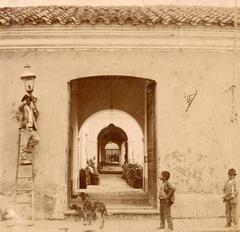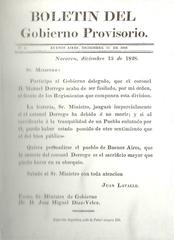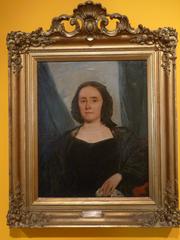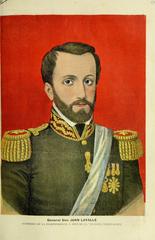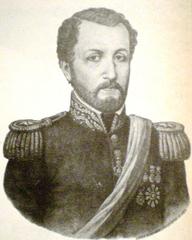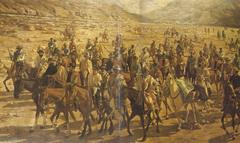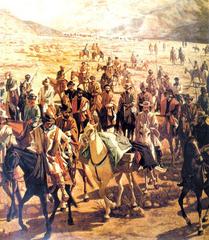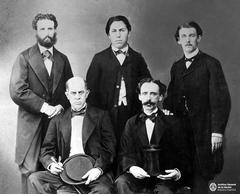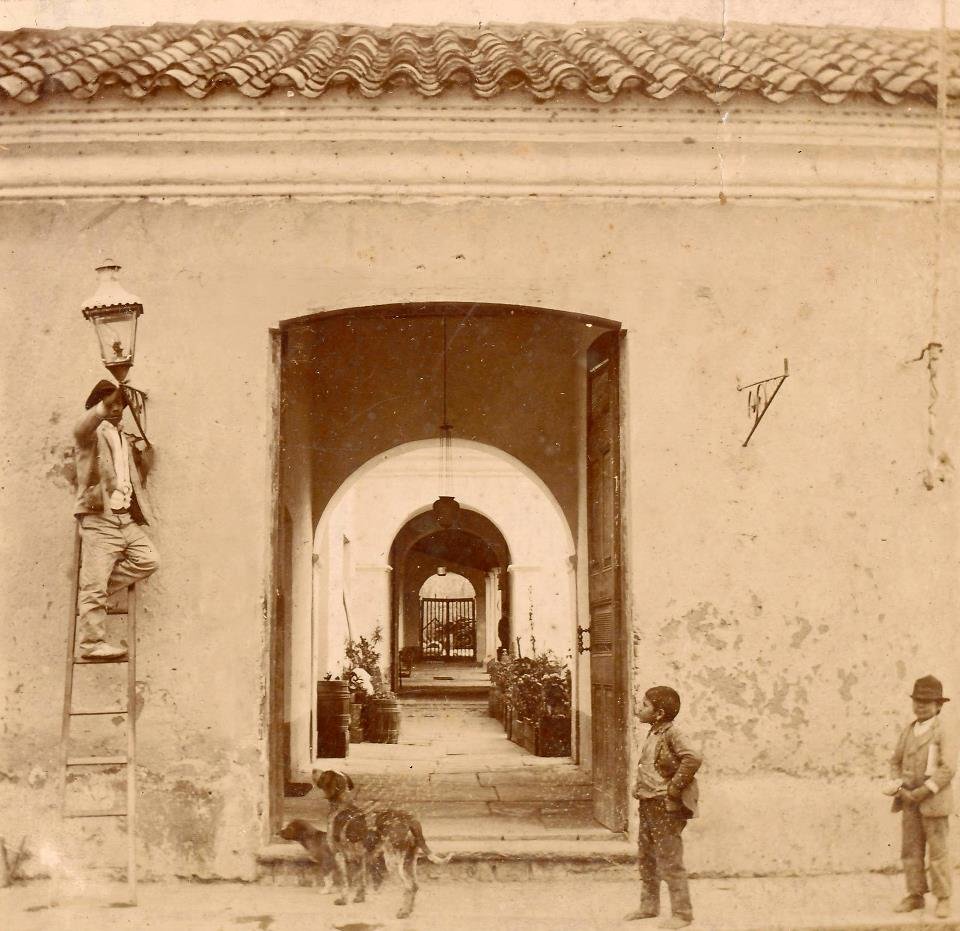
Juan La Balle Visiting Hours, Tickets, and Travel Guide: Buenos Aires Historical Site
Date: 14/06/2025
Introduction
Juan La Balle, located in the fertile Pampas of Buenos Aires province, is a remarkable destination that immerses visitors in Argentina’s rural heritage and the historical evolution shaped by railway expansion. Founded during the early 20th-century railway boom, Juan La Balle is a living testament to the country’s agricultural development, European immigrant influences, and enduring rural traditions. Its blend of well-preserved architecture, vibrant cultural life, and agricultural legacy makes it a must-visit for those seeking an authentic Argentine experience (PlanetWare; Lonely Planet).
Beyond Juan La Balle itself, the greater Buenos Aires region is celebrated for its eclectic mix of architectural styles, iconic plazas, celebrated cultural venues, and dynamic urban life. Landmarks such as the Teatro Colón, the vibrant streets of La Boca, and the majestic Palacio Barolo enhance any itinerary, offering unparalleled insights into Argentina’s history, art, and social fabric (turismo.buenosaires.gob.ar; teatrocolon.org.ar; Palacio Barolo Official).
This comprehensive guide covers the history and significance of Juan La Balle and other Buenos Aires landmarks, with essential visitor information, practical travel tips, details on tickets and opening hours, and recommendations for gastronomy, nightlife, and accessibility. Whether you’re planning a day trip or a deeper cultural exploration, this resource equips you for a rewarding journey through Argentina’s historic and contemporary treasures.
Table of Contents
- Discover Juan La Balle: Historical Background & Visitor Highlights
- Socio-Cultural Evolution
- Architectural and Urban Heritage
- Regional Significance and Preservation Efforts
- Practical Visitor Information & FAQs
- Map of Juan La Balle
- Related Buenos Aires Historical Sites
- Buenos Aires: Architecture, Plazas, and Cultural Venues
- Visiting Palacio Barolo: Hours, Tickets, and Tips
- Juan La Balle Monument: Safety, Accessibility, and Local Experiences
- Gastronomy and Nightlife
- Summary and Key Tips
- References
Discover Juan La Balle: Historical Background & Visitor Highlights
Early History and Foundation
Juan La Balle’s origins are rooted in the late 19th and early 20th centuries, a period defined by Argentina’s railway expansion and agricultural growth. The town is named after a regional development figure, with its foundation closely linked to the arrival of the railway, which shaped civic and commercial life and provided the infrastructure for rapid economic activity (PlanetWare). This foundation mirrored a broader provincial trend, as railway lines gave rise to hundreds of towns with strong European influences, particularly from Spain and Italy (Lonely Planet).
Socio-Cultural Evolution
Immigration and Demographics
The demographic history of Juan La Balle reflects the waves of European immigration that shaped rural Buenos Aires. Italians, Spaniards, and other European settlers introduced agricultural techniques, culinary traditions, and social customs, fusing with local criollo culture. This influence is visible in the town’s architecture, cuisine, and festivals, which feature foods like empanadas and asados (The Crazy Tourist). Community identity remains strong, with social life centered around clubs, churches, and schools.
Cultural Traditions and Festivities
Juan La Balle’s calendar is filled with festivals marking agricultural cycles, patron saints, and national holidays. Traditional music and dances, such as chacarera and zamba, are celebrated, and local artisans showcase their crafts and foods at weekly markets (Gateway Travel).
Architectural and Urban Heritage
Railway Heritage
At the heart of Juan La Balle stands the early 20th-century railway station, a testament to British design influence, with brick facades and wrought iron detailing. Surrounding agricultural infrastructure—warehouses, silos, and docks—speaks to the town’s economic roots (PlanetWare).
Civic and Religious Buildings
The central plaza is bordered by the municipal hall, post office, and a church, displaying a mix of colonial, neoclassical, and Italianate architectural styles. Residential homes typically feature single-story layouts with verandas and tiled roofs, adapted to the local climate (Lonely Planet).
Regional Significance and Preservation Efforts
Agricultural Legacy
Situated in the productive Pampas, Juan La Balle played a crucial role in Argentina’s wheat, corn, and beef industries, with visible remnants of grain elevators and livestock facilities (The Crazy Tourist).
Rural Identity and Social Movements
Throughout the 20th century, the town contributed to rural social change, supporting land reform, education, and cooperative development.
Heritage Conservation and Tourism
Local authorities and cultural associations are actively restoring historic sites, cataloging oral histories, and promoting sustainable tourism. Visitors can experience guided tours, museums, and estancias offering horseback riding and traditional asado feasts (Lonely Planet).
Practical Visitor Information & FAQs
- Location: Juan La Balle, Buenos Aires province. Access via regional highways and limited rail service.
- Visiting Hours: Museums are open Tuesday–Sunday, 10:00 AM–5:00 PM; public plazas open year-round.
- Tickets: Outdoor sites are free; museum entry ARS 100–200 (USD 1–2). Guided tours require advance booking.
- Guided Tours: Available through local tourism offices; book ahead for festivals.
- Accessibility: Public areas mostly accessible; historic buildings may have limited wheelchair access.
- Parking: Free parking near the town center and railway station.
- Language: Spanish is primary; basic English at tourist venues.
- Safety: Generally safe; use standard precautions, especially at night (Gateway Travel).
Frequently Asked Questions
Q: What are the opening hours of Juan La Balle’s historical sites?
A: Most museums and the railway station are open Tuesday–Sunday, 10:00 AM–5:00 PM. Outdoor areas are open year-round.
Q: Is there an entrance fee?
A: Entry to outdoor sites is free. Museums charge ARS 100–200.
Q: Are guided tours available?
A: Yes, book through local tourism offices.
Q: How do I get to Juan La Balle?
A: By regional highways or limited rail service from Buenos Aires city.
Q: Is Juan La Balle family-friendly?
A: Yes, with safe, educational, and cultural activities for all ages.
Map
Explore More: Related Buenos Aires Historical Sites
- Estancia Santa Susana: A Traditional Pampas Ranch Experience
- Luján Basilica: Religious and Architectural Landmark
- Tigre Delta: Nature and Culture near Buenos Aires
Buenos Aires: Architecture, Plazas, and Cultural Venues
Architectural Highlights
Buenos Aires boasts a rich tapestry of styles—colonial, neoclassical, Art Deco, and modernist—shaped by European immigration and 20th-century prosperity (turismo.buenosaires.gob.ar).
Notable structures include:
- Teatro Colón: Renowned for its acoustics and grandeur. Tours daily, 10 AM–5 PM (teatrocolon.org.ar).
- Centro Cultural Kirchner (CCK): Latin America’s largest cultural center, 10 AM–8 PM (matadornetwork.com).
- El Ateneo Grand Splendid: An opulent bookstore, open daily 9 AM–10 PM (nomadicmatt.com).
- Recoleta Cemetery: Art Nouveau and Art Deco mausoleums; 8 AM–6 PM (foodandtravelutsav.com).
- La Boca’s Caminito: Famous for colorful houses and street art.
Iconic Plazas
- Plaza de Mayo: Surrounded by the Casa Rosada and Metropolitan Cathedral, open 24/7 (ucityguides.com).
- Plaza Dorrego: Antiques market Sundays, 10 AM–5 PM.
- Plaza Lavalle: Next to Teatro Colón, open year-round (matadornetwork.com).
Cultural Venues
- Centro Cultural Recoleta: Contemporary arts, 11 AM–8 PM (matadornetwork.com).
- Museo Nacional de Bellas Artes: Open 11 AM–7 PM (bellasartes.gob.ar).
- MALBA: Latin American art, 12 PM–8 PM (malba.org.ar).
- San Telmo Market: Daily 10 AM–6 PM.
- Usina del Arte: Concerts and exhibitions, Thursday–Sunday (wanderlog.com).
Visitor Tips
- Most museums open 10 AM–8 PM, closed Mondays/Tuesdays.
- Many offer free admissions on select days.
- Subte (metro), buses, and taxis provide easy transport.
- Use smart casual attire for performances.
- Daytime visits recommended for safety.
Visiting Palacio Barolo: Hours, Tickets, and Travel Tips
History and Significance
The Palacio Barolo, designed by Mario Palanti and completed in 1923, draws inspiration from Dante’s Divine Comedy. Its neo-Gothic and Art Nouveau features, along with a symbolic division into Hell, Purgatory, and Heaven, mark it as one of Buenos Aires’ most intriguing landmarks (Palacio Barolo Official).
Visiting Details
- Hours: Tuesday–Sunday, 10:00 AM–6:00 PM.
- Tickets: ARS 1000–1500 (USD 5–8); discounts for students/seniors; booking online recommended.
- Tour: Includes the lobby, upper floors, and lighthouse with panoramic city views.
- Accessibility: Elevator to most floors, but some stair access required.
- Getting There: Avenida de Mayo 1370, near Lima (Line A) subway.
Practical Tips
- Arrive early, wear comfortable shoes.
- Photography allowed (no flash/tripods).
- Combine with nearby attractions and historic cafés.
Juan La Balle Monument: Safety, Accessibility, and Local Experiences
Monument Details
- History: Erected in the early 20th century, commemorating Juan La Balle’s role in Argentina’s independence and cultural history.
- Hours: Daily, 9:00 AM–7:00 PM (to 9:00 PM weekends).
- Tickets: ARS 200 (USD 2); free for residents/children under 12.
Safety and Accessibility
Buenos Aires is generally safe for tourists, though petty theft can occur in crowded areas. Use official taxis or reputable ride-sharing apps, remain vigilant, and avoid displaying valuables (Nannybag). Tourist police are present in major zones.
Most central attractions are accessible, though some older infrastructure may pose challenges. Main subway lines, buses, and some taxi services offer accessibility features (Short Girl on Tour).
Gastronomy and Nightlife
Cuisine
Buenos Aires cuisine is a blend of Argentine and European influences. Don’t miss parrillas (steakhouses), empanadas, and milanesa. Italian and Spanish dishes are widespread, and contemporary dining is thriving, with Michelin-starred options and vegetarian/vegan choices (Explore Your Bucket List; Time Out Buenos Aires).
Nightlife
Experience tango at milongas, enjoy live music, or explore the clubs and rooftop bars of Palermo and San Telmo. The LGBTQ+ scene is vibrant and welcoming (Nightlife Party Guide).
Summary and Key Tips
Juan La Balle and Buenos Aires present an inspiring blend of rural heritage, grand architecture, and vibrant culture. From historic railway stations and cultural festivals to renowned landmarks like Teatro Colón and Palacio Barolo, there’s much to discover. Plan ahead for tickets and accessibility, enjoy local gastronomy and nightlife, and use guided tours to enhance your understanding. Engaging with local conservation efforts and community initiatives will enrich your visit and help preserve these historical gems for the future. For personalized itineraries, guided tours, and real-time updates, download the Audiala app and follow official tourism channels (PlanetWare; teatrocolon.org.ar; Palacio Barolo Official; Nannybag).
References
- PlanetWare – Buenos Aires Tourist Attractions
- turismo.buenosaires.gob.ar – Buenos Aires Architecture
- Palacio Barolo Official
- Nannybag Guide – Buenos Aires Safety
- Nightlife Party Guide – Buenos Aires Nightlife
- Teatro Colón Official
